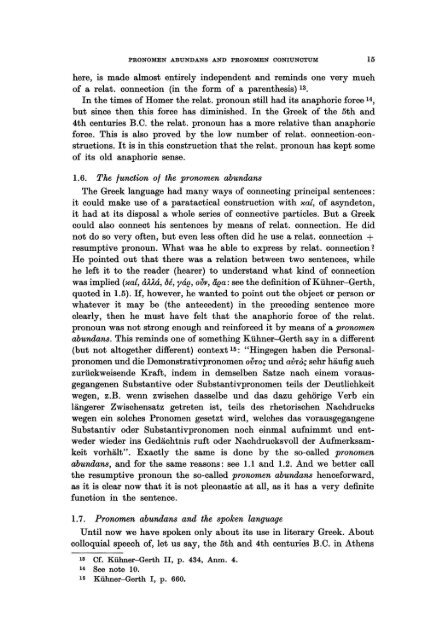Pronomen Abundans and Pronomen Coniunctum. A ... - DWC
Pronomen Abundans and Pronomen Coniunctum. A ... - DWC
Pronomen Abundans and Pronomen Coniunctum. A ... - DWC
You also want an ePaper? Increase the reach of your titles
YUMPU automatically turns print PDFs into web optimized ePapers that Google loves.
PRONOMEN ABUNDANS AND PRONOMEN CONIUNCTUM 15<br />
here, is made almost entirely independent <strong>and</strong> reminds one very much<br />
of arelat. connection (in the form of a parenthesis) 13.<br />
In the times of Homer the relat. pronoun still had its anaphoric force 14,<br />
but since then this force has diminished. In the Greek of the 5th <strong>and</strong><br />
4th centuries B.C. the relat. pronoun has a more relative than anaphoric<br />
force. This is also proved by the low number of relat. connection-constructions.<br />
It is in this construction that the relat. pronoun has kept some<br />
of its old anaphoric sense.<br />
1.6. The function of the pronomen abundans<br />
The Greek language had many ways of connecting principal sentences :<br />
it could make use of a paratactical construction with 'Xat, of asyndeton,<br />
it had at its disposal a whole series of connective particles. But a Greek<br />
could also conneet his sentences by means of relat. connection. He did<br />
not do so very of ten, but even less of ten did he use arelat. connection +<br />
resumptive pronoun. What was he ab Ie to express by relat. connection ?<br />
He pointed out that there was arelation between two sentences, while<br />
he left it to the reader (hearer) to underst<strong>and</strong> what kind of connection<br />
was implied ('Xat, à)')'á, bÉ, yáe, ow, (J.ea: see the definition of Kühner-Gerth,<br />
quoted in 1.5). If, however, he wanted to point out the object or person or<br />
whatever it may be (the antecedent) in the preceding sentence more<br />
clearly, then he must have feIt that the anaphoric force of the relat.<br />
pronoun was not strong enough <strong>and</strong> reinforeed it by means of a pronomen<br />
abundans. This reminds one of something Kühner-Gerth say in a different<br />
(but not altogether different) context 15: "Hingegen haben die Personalpronomen<br />
und die Demonstrativpronomen ovroç und avrdç sehr häufig au eh<br />
zurückweisende Kraft, indem in demselben Satze nach einem vorausgegangenen<br />
Substantive oder Substantivpronomen teils der Deutlichkeit<br />
wegen, z.B. wenn zwischen dasselbe und das dazu gehörige Verb ein<br />
längerer Zwischensatz getreten ist, teils des rhetorischen Nachdrucks<br />
wegen ein solches <strong>Pronomen</strong> gesetzt wird, welches das vorausgegangene<br />
Substantiv oder Substantivpronomen noch einmal aufnimmt und entweder<br />
wieder ins Gedächtnis ruft oder Nachdrucksvoll der Aufmerksamkeit<br />
vorhält". Exactly the same is done by the so-called pronomen<br />
abundans, <strong>and</strong> for the same reasons: see l.1 <strong>and</strong> l.2. And we better caU<br />
the resumptive pronoun the so-called pronomen abundans henceforward,<br />
as it is clear now that it is not pleonastic at all, as it has a very definite<br />
function in the sentence.<br />
1.7. <strong>Pronomen</strong> abundans <strong>and</strong> the spoken language<br />
Until now we have spoken only about its use in literary Greek. About<br />
colloquial speech of, let us say, the 5th <strong>and</strong> 4th centuries B.C. in Athens<br />
13 Cf. Kühner-Gerth 11, p. 434, Anm. 4.<br />
14 See note 10.<br />
15 Kühner-Gerth I, p. 660.
















